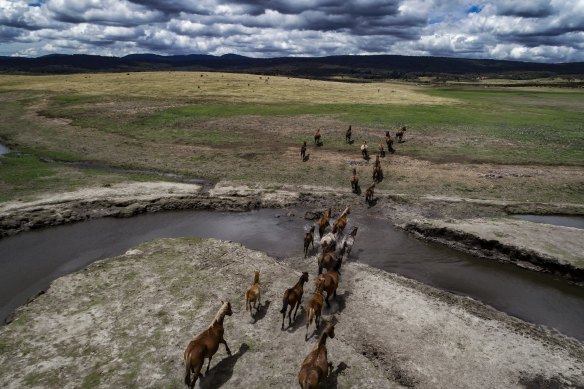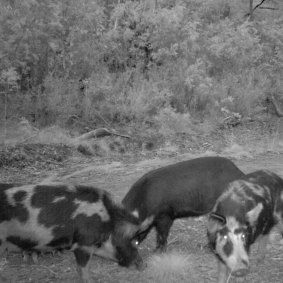Why shooting feral animals from the sky might be the best way to protect ecosystems
By Laura Chung
Shooting animals from helicopters is responsible for the vast majority of invasive species culled in NSW, data shows, as the government considers whether to expand the practice to the booming feral horse numbers in Kosciuszko National Park.
In the past three years almost 272,000 feral animals were killed across NSW using aerial shooting, ground shooting and trapping, government data shows.

NSW is considering aerial shooting to tackle feral horse numbers in the Kosciuszko National Park, but the method has proven to be the most effective method to deal with other feral animal populations.Credit: Wolter Peeters
This included about 192,000 feral pigs, 32,400 feral deer and 47,650 other feral animals (such as goats, foxes and cats).
Of these, 88 per cent were through aerial shooting, compared to 6 per cent for ground shooting and 6 per cent for trapping. The number of feral animals removed has increased.
Feral animal management was carried out by National Parks and Wildlife Services and Local Land Services in national parks, crown land and private property.
Invasive Species Council Advocacy Manager Jack Gough said invasive species were an environmental disaster.
“They trash and trample streams and wetlands, strip the bark from trees and are pushing our native wildlife to the brink of extinction,” he said. “No one likes to see animals killed, but the sad reality is that we have a choice to make between urgently reducing feral animals or accepting the decline and extinction of native animals.
“The numbers here paint a clear picture. Aerial shooting by highly trained professionals has accounted for almost 90 per cent of the over 270,000 feral animals removed by shooting or trapping in the past three years.”
The NSW government is considering whether to amend regulations to allow aerial shooting of feral horses in Kosciuszko National Park.
Feral horse populations in the park have increased by more than 30 per cent in two years despite state government reduction targets, prompting experts to demand a bigger culling effort.
Good rainfall in the past three years has contributed to the population boom.
The animals are damaging the environment and putting more than 30 threatened native species at risk.
The data shows aerial shooting numbers are highest in regional areas, including in western NSW where 11,439 feral animals were shot last financial year, and in the northern inland where 10,275 were killed.

About 191,950 feral pigs have been killed across NSW in the last three financial years, with aerial shooting responsible for 91 per cent of their removal.
Ground shooting was more common in western NSW and the Greater Sydney region where 1834 and 246 feral animals were killed, respectively. Northern inland NSW and the Blue Mountains region rely heavily on trapping.
A NSW National Parks and Wildlife Service spokesperson said it was committed to delivering the biggest feral animal program in history and had increased the number of officers carrying out management.
A spokesperson for RSPCA NSW said it acknowledged aerial shooting could be a relatively humane method of pest management that was effective.
But the spokesperson said the method was only humane if shooters and pilots were accurate and worked in favourable environments.
“As an enforcement agency, we are bound by the parameters within the legislation we enforce, and we are committed to investigating allegations of cruelty and undertaking enforcement action where necessary,” the RSPCA spokesperson said.
Separately, a Senate inquiry into feral horse management is expected to hand down its findings in the coming days.
Get to the heart of what’s happening with climate change and the environment. Sign up for our fortnightly Environment newsletter.